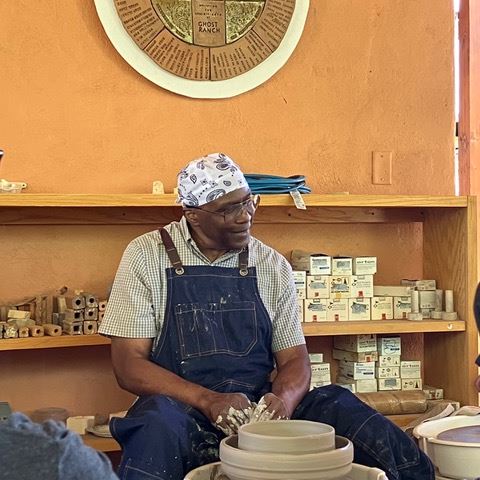 Slip Trail editor shares notes, photos, memories from the James Watkins Ghost Ranch Workshop – August 18-20, 2023.
Slip Trail editor shares notes, photos, memories from the James Watkins Ghost Ranch Workshop – August 18-20, 2023.
I got to the Ranch a day early to get a campsite, and thus was able to be there when James Watkins first arrived to Piñon Pottery Studio. He had left his home in Lubbock at 4:30 am, in his large extended cab pickup with trailer, transporting himself, his wife and her mother – they arrived around noon on Friday. After not being able to fit through the west entrance to Piñon, he drove his truck and trailer around the north/back side, which ended up providing the perfect space to accommodate all the containers of his large vessels as well as firing equipment and supplies under the ample portal. Our teacher had come very well-prepared.
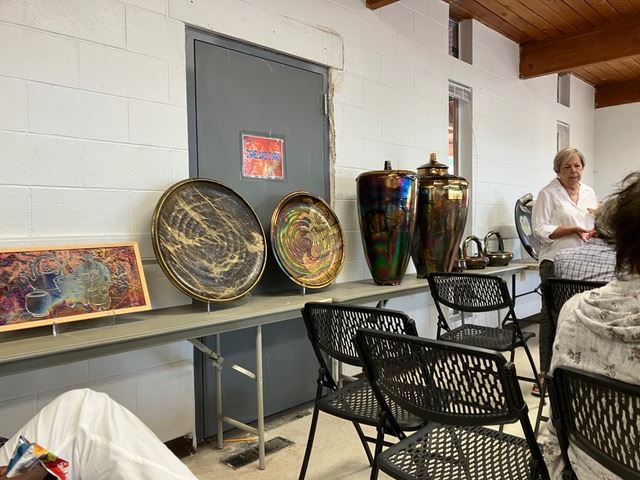
Array of distinctive clay works by James Watkins. Photo: Cirrelda Snider-B.
Classroom 2, already set up with slide projector and rows of chairs, became the ‘gallery’ as a number of us participants carried in piece after piece of the huge, gorgeous wares. After 3 pm, when it seemed all participants were gathered, James Watkins began his slide show introduction to our weekend.
Watkins began his presentation with a piece he described as having a “deep, gun metal black.” 3M tape was used to mask off design, and sticky-backed paper made especially for bisque ware. James’s comment, “You collect memories,” led us into his broad overview.
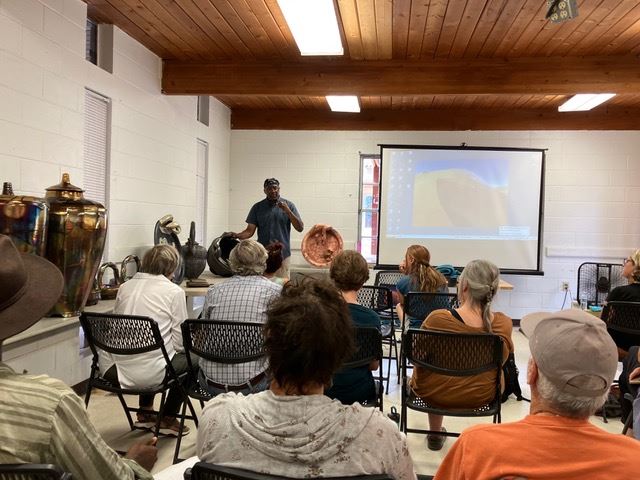
James Watkins addresses participants at the beginning of the workshop. Photo: Cirrelda Snider-B.
He began by sharing the trajectory with his clay practice: 1978-1983 Mackenzie Terrace Pottery Center in Lubbock, TX. 1983-2018 he taught Architectural Ceramics at Texas Tech. Since 2018, his own studio is his nexus: JCW Clayworks at Junction Center. Thus, he has been 34 years in Junction, TX.
Of his influences, he shared, “Wide open spaces of Lubbock!” He collects dust from dust storms to make terra sigilatta slips. He collects clay from canyons and deserts to experiment with textures.
Another influence are the pictographs near the Mexico border around Langtry, TX. He took students there for two days of camping, telling them no copying of the pictographs allowed. His “Rattlesnake Canyon platters” were influenced by this place.
More influences were shared: “Covered jars influenced by cotton gin. Luster inspired by sunsets. Copper black. Martial arts training concept: “relaxation and explosiveness.” Another influence was crafted after a vessel his grandmother made “soap” (food) in - soap (pronounced 'saw-oop') big black urns. Then, vessels using the “cattle feeder” shape. Vessels were also inspired by field furrows. Tiles were created by James to echo irrigation circles and playa lakes.
Watkins also had influences from his travels. In 1994, he traveled to Japan, “East meets West.” It was during his Artist in Residency there that the double walled platters, Raku-fired, began. Tea bowls were created and anagama kiln-fired, with no glazes.
During another trip, this time to Hong Kong in 2001-2, he produced his “Shinto Toru Gates” piece. They were created after wrapping with toilet paper, then fired to cone 017, with hold for one hour. More influences came from Hong Kong bamboo scaffolding. Another trip was made to Cambodia, Laos, and Vietnam in 2004.
Along the way, a number of books have been published, including Alternative Kilns and Firing Techniques: Pit, Barrel, Raku, Saggar (2004)*.
In 2018 he retired to put energy into his studio.
A far-ranging lecture, we had just been given the background for all the methods we would be introduced to over the weekend.
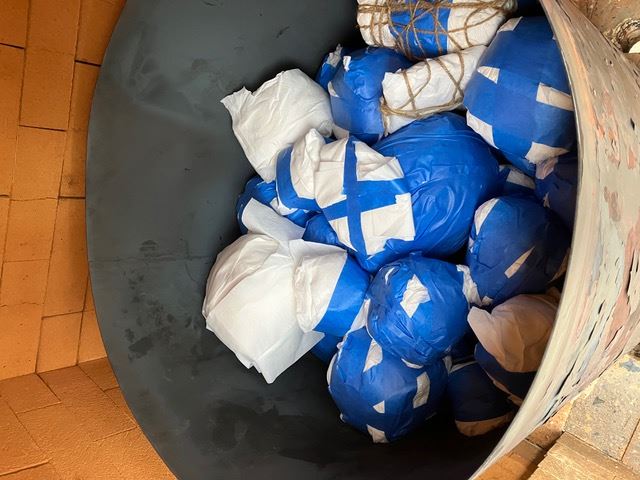
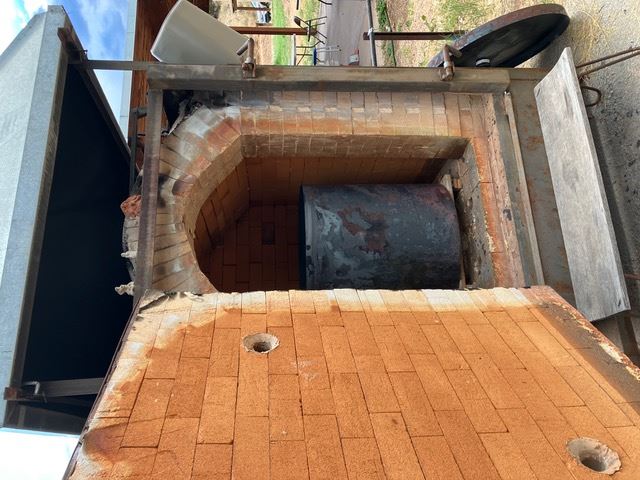
"Black on Black" pieces wrapped in toilet paper, loaded into JW's canister. Photo: Cirrelda Snider-B.

Friday evening "Black on Black" firing with Michael Thornton checking pyrometer. Photo: Cirrelda Snider-B.
Black on Black activity
Friday evening, we had our first activity – Black on Black – like the very first piece he showed in the slide show. We took a bisque fired piece or two we had brought with us and applied slip and auto detailing tape. After applying terra sig, we burnished with plastic bag, then wrapped with TP up to 1” thick. After binding with masking tape, the pieces were piled into James’s own round metal firing bin with lid that he’d brought. The big bin went into gas kiln, and was fired to 1500 degrees F. All of us mingled in the kiln yard while the gas kiln was started, then monitored, and shut off after reaching 1500 degrees. (Leonard and Cirrelda paid a visit to Barbara Campbell up at Long House where her son had just gotten married, to see if she had any advice to lend about the gas kiln. ;)
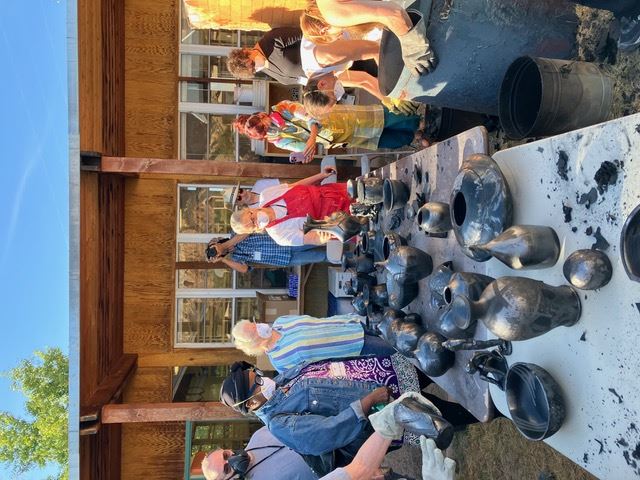
"Black on Black" pieces after being unwrapped. Photo: Cirrelda Snider-B.
Saturday morning first thing after breakfast, we unloaded the Black on Black pieces that were nicely cooled down.
Naked Raku activity
Next up was the Naked Raku Activity. (See p. 39 for Terra Sigillata slip recipe in Watkins’ book *Alternative Kilns and Firing Techniques.)
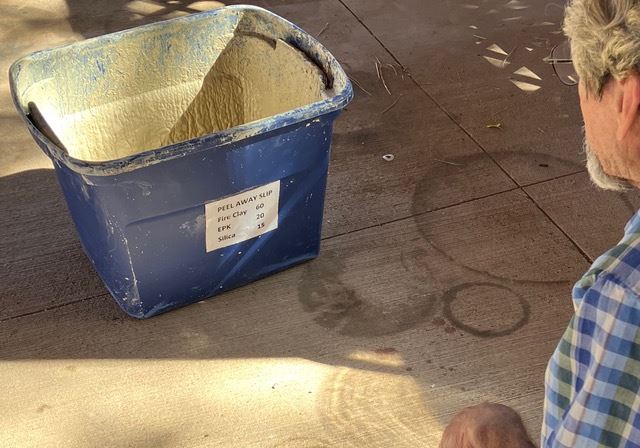
Peel Away Slip bin with Lee Akins. Photo: Cirrelda Snider-B.
We used same Terra Sig slip as last night for Raku. With the addition of a Peel Away Slip “dip” right before firing (recipe on the plastic bin: Fire Clay 60, EPK 20, Silica 15). Slipped pots awaiting firing were placed on a table, then we went to lunch.
Throwing Demo
After breaking for lunch, we paused the firings for a bit to watch James throw a double-walled pot. JW: “I imagine there’s a hole in the center of that bat, and that I’m trying to push clay into that hole.”
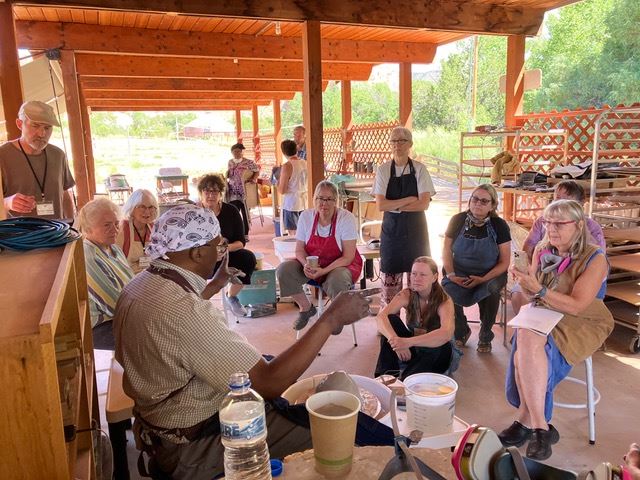
James Watkins throwing a double-walled vessel. Photo: Cirrelda Snider-B.
He shared story of discovering double wall from his dream. “Takes a few days to throw very large bowls – wait til it gets stiff.” James slowly finished the double wall vessel on wheel – over 3 hours – draped plastic over during lunch break. Methodical. Conveying anecdotes along the slow throwing process.
Raku
Then it was time to do the Raku firings. We used the small Raku kiln under porch roof, and did around 10 firings of 6 pieces average at a time. We got caught up in the thrill of Raku. Lee Akins and Leonard Baca dedicated much time to help these firings happen.
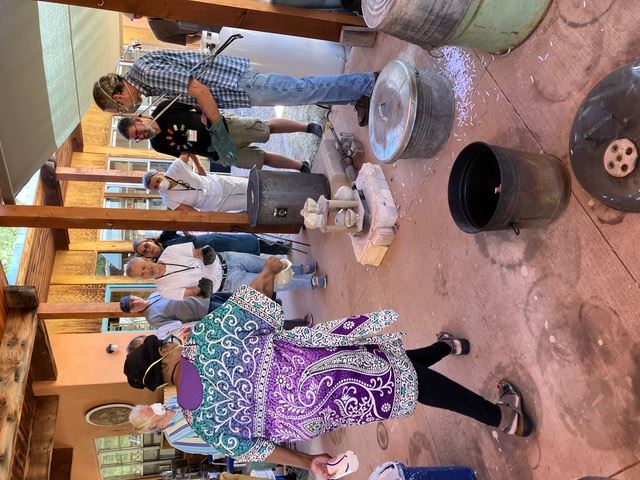
Jennifer Stewart bringing her dipped pieces to the kiln. Photo: Cirrelda Snider-B.
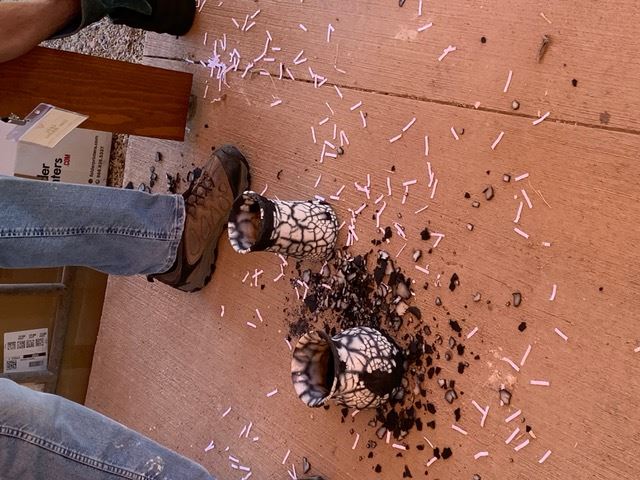
Naked Raku. Photo: Kathleen Allen.
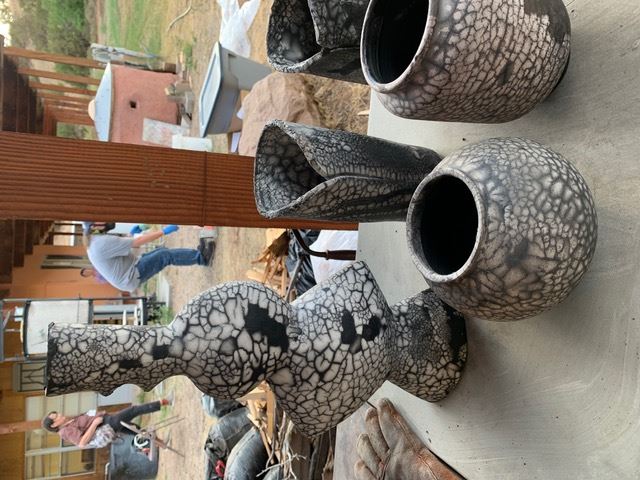
Naked Raku pieces by Sharon Brush, Charlotte Ownby. Photo: Kathleen Allen.
Throughout the afternoon and into the evening, participants set off with their fresh "NM SOL" cone 10 clay (from New Mexico Clay in Albuquerque), many taking advantage of the 15 wheels that were available to throw on, though a few folks did some hand-building, too.
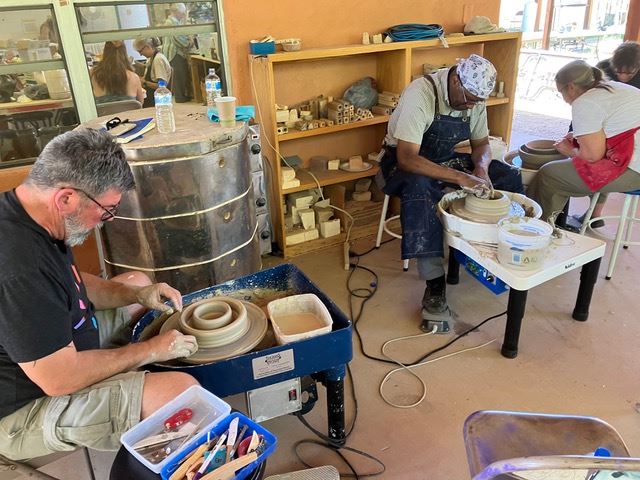
Left: David Blackwell. Center: James Watkins. Right: Sharon Brush & Sheryl Zacharia. Photo: Cirrelda Snider-B.

Throwing double wall forms. Left to right: Michael Thornton, Christiane Couvert, Brant Palley, Joan Eichelberger. Photo: Cirrelda Snider-B.
Saggar with stannous chloride
After dinner, we were introduced to the final Activity -- Saggar with stannous chloride (mask needed!) and myriad coverings, including lichen, etc. Each participant concocted their own personal applications on multiple pieces, ending with tightly wrapped foil. Then we each personally loaded our foil bundles on the growing heap of individual saggars inside the gas kiln again.
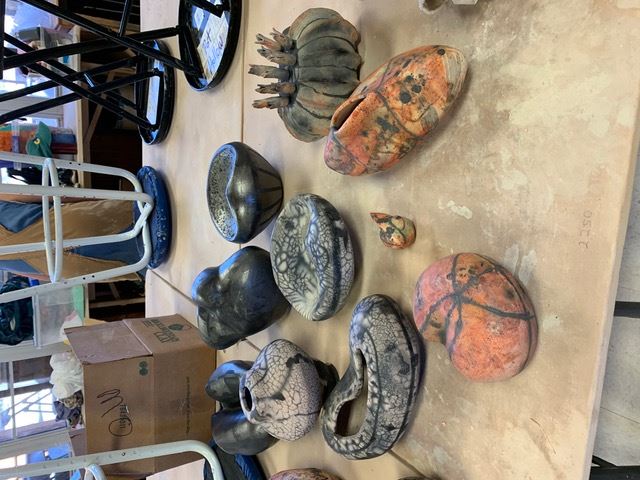
Stannous chloride sagger-fired pieces by Cate McClain. Photo: Kathleen Allen.
The kiln was lit and the firing began as we hung around with new and old friends, deep in conversations as the pyrometers registered climbing temps, and finally reached the 1500 degrees again.
After a delicious breakfast together on Day 3, we unloaded Saggar pieces. Group photo shot in front of gas kiln. Made our good-byes, as James and family had to make the long drive back to Lubbock. Then of course, we relished the clean up!

Group photo by Leonard Baca.
Photo album from the workshop viewable here.
--Solidarity, Cirrelda Snider-Bryan.
Grateful for help from Kathleen Allen, Charlotte Ownby, Brant Palley, Michael Thornton in reviewing this article.


